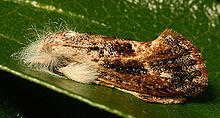| Acrolophinae | |
|---|---|

| |
| Acrolophus species | |
| Scientific classification | |
| Domain: | Eukaryota |
| Kingdom: | Animalia |
| Phylum: | Arthropoda |
| Class: | Insecta |
| Order: | Lepidoptera |
| Family: | Tineidae |
| Subfamily: | Acrolophinae Busck, 1912 |
| Genera | |
|
See text | |
Acrolophinae is a family of moths in the order Lepidoptera.[1][2] The subfamily comprises the burrowing webworm moths and tube moths and holds about 300 species in five genera, which occur in the wild only in the New World.[3] It is closely related to the family Tineidae.[4]
Genera[edit]
References[edit]
- ^ van Nieukerken, Erik J.; Kaila, Lauri; Kitching, Ian J.; Kristensen, Niels P.; Lees, David C.; Minet, Joël; Mitter, Charles; Mutanen, Marko; Regier, Jerome C.; Simonsen, Thomas J.; Wahlberg, Niklas; Yen, Shen-Horn; Zahiri, Reza; et al. (23 December 2011). Zhang, Zhi-Qiang (ed.). "Order Lepidoptera Linnaeus, 1758" (PDF). Zootaxa. Animal biodiversity: An outline of higher-level classification and survey of taxonomic richness. 3148: 212–221. Archived (PDF) from the original on 10 June 2014. Retrieved 2 February 2023.
- ^ Regier, Jerome C.; Mitter, Charles; Davis, Donald R.; Harrison, Terry L.; Sohn, JAE-Cheon; Cummings, Michael P.; Zwick, Andreas; Mitter, KIM T. (2015). "A molecular phylogeny and revised classification for the oldest ditrysian moth lineages (Lepidoptera: Tineoidea), with implications for ancestral feeding habits of the mega-diverse Ditrysia". Systematic Entomology. 40 (2): 409–432. doi:10.1111/syen.12110. S2CID 85287782.
- ^ Heppner, John B. (2008), "Tube Moths (Lepidoptera: Acrolophidae)", in Capinera, John L. (ed.), Encyclopedia of Entomology, Dordrecht: Springer Netherlands, pp. 3953–3954, doi:10.1007/978-1-4020-6359-6_2584, ISBN 978-1-4020-6359-6
- ^ Deyrup, M.; Deyrup, N. D.; Eisner, M.; Eisner, T. (2005). "A Caterpillar that Eats Tortoise Shells". American Entomologist. 51 (4): 245–248. doi:10.1093/ae/51.4.245. ISSN 2155-9902.
External links[edit]
Well, that’s interesting to know that Psilotum nudum are known as whisk ferns. Psilotum nudum is the commoner species of the two. While the P. flaccidum is a rare species and is found in the tropical islands. Both the species are usually epiphytic in habit and grow upon tree ferns. These species may also be terrestrial and grow in humus or in the crevices of the rocks.
View the detailed Guide of Psilotum nudum: Detailed Study Of Psilotum Nudum (Whisk Fern), Classification, Anatomy, Reproduction